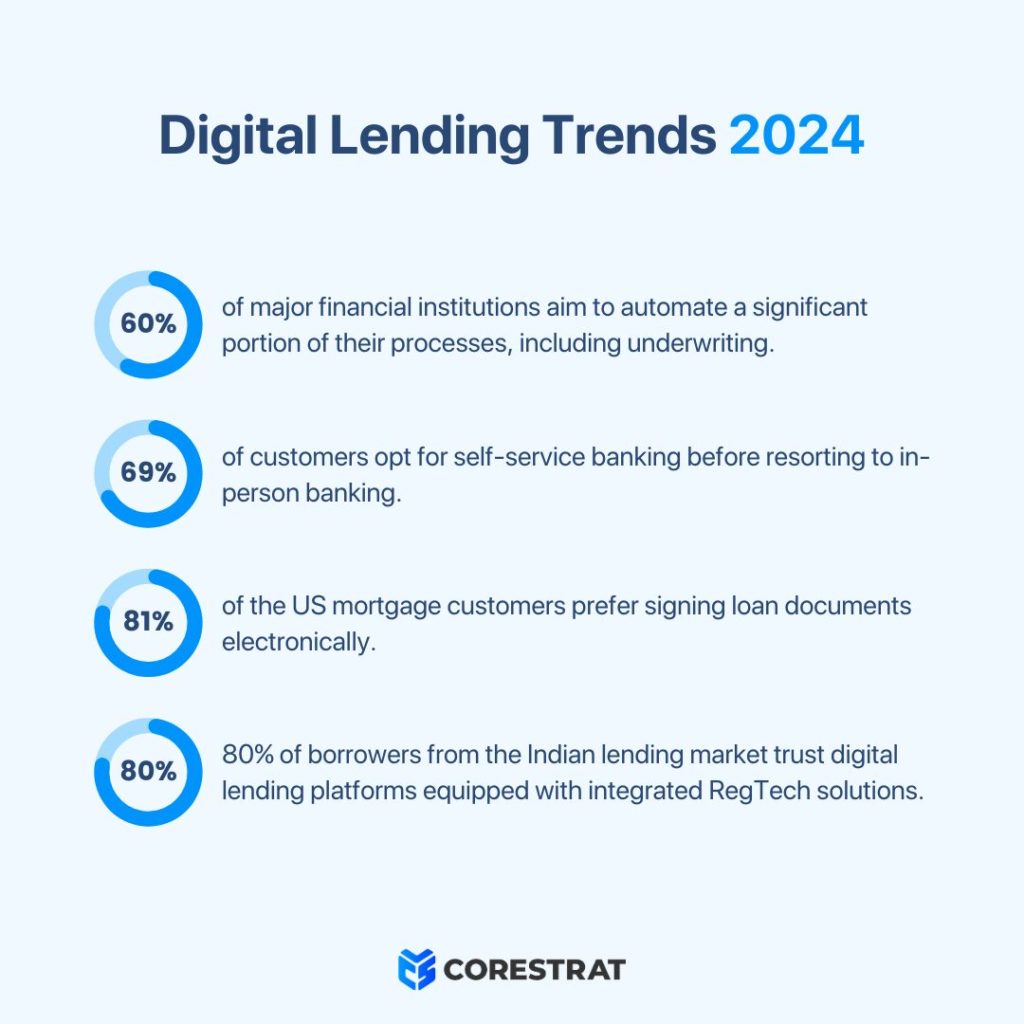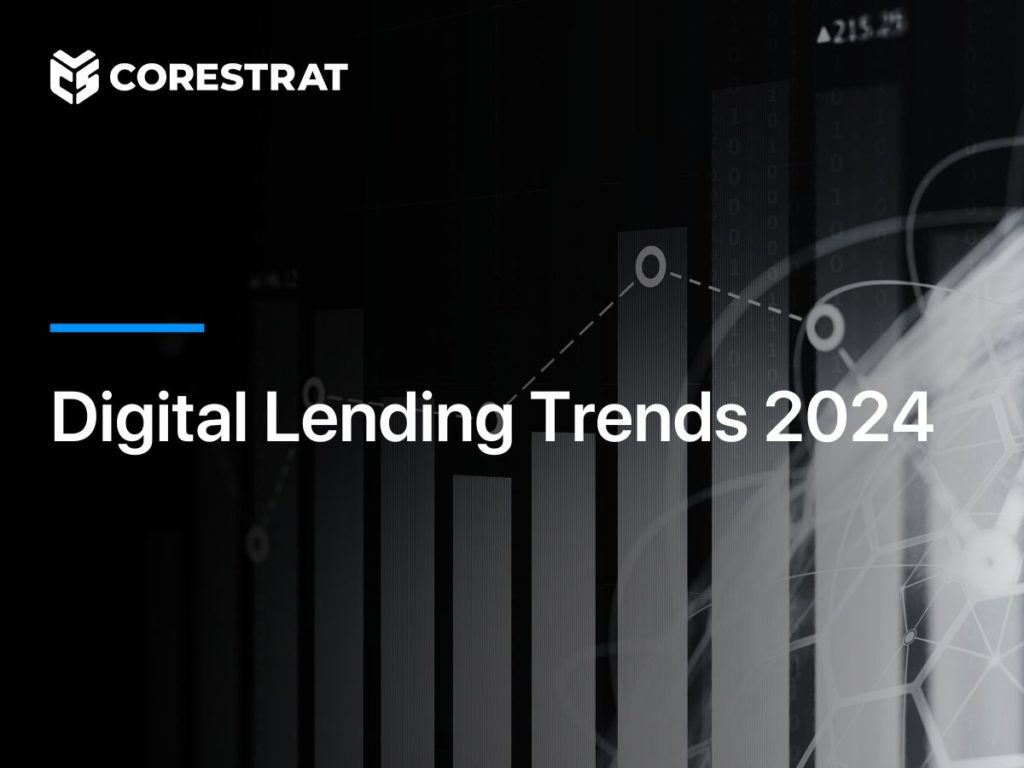In recent times, the lending landscape has witnessed substantial changes, thanks to technological advancements. The influence of digitalization is sweeping across industries, and lending is no exception.
As the digital lending market is poised to reach $71.8 billion globally by 2032, financial institutions, including banks and non-banking financial companies (NBFCs), are actively introducing innovative lending techniques. These initiatives are simplifying the process for both consumers and businesses to access capital through digital channels.
Lending institutions are diversifying their lending models, whether it’s Buy Now Pay Later (BNPL) or invoice-based financing, to meet the growing credit demand. Their emphasis is on secure automation and digitization of the entire lending process, leveraging advanced technologies to enhance the overall borrower experience.
With the digital lending market set for remarkable growth at a CAGR of 19.4% from 2023 to 2032 and aiming to optimise the lending landscape, let’s explore some key digital lending trends 2024 that promise to streamline and improve the overall lending process.

Self-service and Omnichannel Capabilities
With 69% of customers opting for self-service before resorting to in-person banking, the integration of self-service and omnichannel capabilities has become necessary in digital lending. This strategic inclusion is key to improving both operational efficiency and the overall customer experience. Self-service enables borrowers to independently navigate and complete various lending processes online, such as application submission and document upload, fostering convenience and flexibility.
Omnichannel capabilities involve the seamless integration of various channels (e.g., website, mobile app, in-person) to provide a unified and consistent customer experience across all touchpoints. The integration of these capabilities not only improves customer satisfaction through enhanced convenience and choice but also streamlines processes, reduces operational costs, and provides a competitive edge for the lending institutions in the digital lending landscape.
Thanks to this, borrowers can now skip the hassle of visiting banks and interact with lenders only when necessary. Simultaneously, employees are liberated from redundant, low value tasks.
AI-powered Underwriting
In the complex realm of loan underwriting, financial institutions face numerous challenges that can hinder the efficiency and accuracy of the loan approval process. Traditional underwriting methods often struggle with time-intensive tasks, intricate data analysis, and the risk of human errors, resulting in delays and heightened operational costs. The demand for a more efficient and technologically advanced approach has instigated a paradigm shift in the industry, with Artificial Intelligence (AI) emerging as a revolutionary force set to reshape the loan underwriting landscape.
Nearly 60% of major financial institutions aiming to automate a significant portion of their processes, including underwriting, signals the imminent rise of AI-powered underwriting as the next major development in digital lending.
AI-powered underwriting in digital lending refers to the application of artificial intelligence (AI) and machine learning algorithms to assess the creditworthiness of loan applicants. This approach automates and improves the traditional underwriting process by analysing vast amounts of data, developing dynamic credit scoring models, and providing real-time, personalised risk assessments.
The use of AI enhances accuracy, efficiency, and speed in decision-making, allowing for quicker loan approvals or denials. Automation reduces the reliance on manual processes, ensuring consistency and mitigating human bias. AI-powered underwriting adapts to changing economic conditions, continuously learns from data, and provides lenders with a competitive advantage by offering faster, more accurate, and personalised lending decisions. Overall, it streamlines the lending process, improves credit risk management, and enhances the customer experience in the digital lending landscape.
Integration of E-signing & Digital Closing in Lending
Currently, despite significant automation in the lending sector, many financial institutions still insist on borrowers signing the final loan application in person rather than using e-signatures. The primary reason for this cautious approach is the potential risks associated with identity fraud.
However, the landscape is expected to evolve in the near future, driven by the increasing integration of AI and ML within lending technologies. This integration enhances the scrutiny of loan applications, providing lending institutions with the confidence to seamlessly adopt e-signing for the digital closure of loan applications, mitigating concerns about identity fraud.
According to a recent survey of the mortgage industry, 81% of respondents expressed a preference for signing loan documents electronically. These findings underscore a growing acceptance and readiness among consumers for digital solutions in the lending process, highlighting a shifting trend towards increased adoption of electronic signatures and entirely digital lending experiences.
The integration of e-signing and digital closing in lending involves utilising electronic signatures and digital processes for the final stages of a loan transaction. This includes the signing of documents and closing the loan agreement. E-signing enables borrowers to sign documents electronically, streamlining processes and providing a secure alternative to traditional paper signatures. Key aspects include digital document management, workflow automation, and remote accessibility. The importance of this integration lies in its ability to enhance efficiency and speed, reduce costs, improve security and compliance solutions in digital lending, offer a better customer experience, minimise errors, and adapt to remote work trends.
B2B BNPL (Buy Now Pay Later)
The conventional invoice-based payment methods in B2B transactions frequently entail potential fees, rigid deadlines, and restricted flexibility. Small businesses, lacking immediate access to the required capital, face barriers to obtaining goods and services as they must pay the entire amount upfront. This limitation can impede growth and result in missed opportunities for small companies seeking to leverage products for success. Enter B2B BNPL, a solution that proves especially beneficial for small and medium enterprises.
B2B BNPL (Business-to-Business Buy Now, Pay Later) is a financial arrangement allowing businesses to defer payments for purchases over time, typically through instalment plans. This model, an extension of the popular consumer BNPL concept, offers improved cash flow management, enhanced purchasing power, and flexible payment options for businesses.
By digitising transactions and providing adaptable payment structures, B2B BNPL aligns with changing business models, supports financial inclusion for small and medium-sized enterprises, and contributes to the adoption of modern financial technologies. It serves as a competitive advantage, especially for businesses seeking innovative and flexible financing solutions in the evolving digital economy.
Blockchain for Secure Transactions
According to projections from the World Economic Forum, by 2027, a minimum of 10% of the GDP is anticipated to be blockchain-related. This transformative trend is expected to impact various sectors, and digital lending is poised to be a significant beneficiary of the blockchain revolution.
Blockchain technology is crucial for secure transactions in digital lending due to its decentralised and distributed ledger system. Even though there are reports regarding often security breaches, measures are being taken to prevent those breaches and make it a safe and secure mode for transaction.
The transparency and traceability of blockchain transactions enhance overall security, and smart contracts automate lending processes, reducing the need for intermediaries and minimising errors.
Blockchain’s decentralisation improves system resilience, leading to more efficient and cost-effective lending operations. It also provides an immutable audit trail for compliance, facilitates cross-border transactions, and can act as a powerful tool for fraud detection and prevention.
RegTech
RegTech, or Regulatory Technology, is a critical component in digital lending, employing technology to streamline and enhance compliance with regulatory requirements. In the context of digital lending, RegTech is important for several reasons. It significantly improves the efficiency of compliance processes, reducing costs associated with manual efforts. Reports indicate that in India, a staggering 80% of consumers place their trust in digital lending platforms equipped with integrated RegTech solutions. The impact is evident as loan defaults have seen a significant reduction of 30%, underscoring the positive influence of incorporating regulatory technology into digital lending platforms.
Real-time monitoring capabilities help identify and address regulatory compliance issues promptly, while data analytics facilitates accurate reporting and risk management. The adaptability of RegTech to regulatory changes is crucial, and its integration with blockchain enhances security and transparency. RegTech also contributes to streamlined customer onboarding, creating audit trails for documentation, and addressing cross-border compliance challenges. Overall, RegTech in digital lending ensures that financial institutions can navigate complex regulatory environments effectively, fostering a secure, transparent, and compliant financial ecosystem.
Conclusion
Digital lending is rapidly emerging as the new phenomenon in the lending industry. As contemporary borrowers increasingly favour digital lending over traditional practices, lending institutions must adapt to meet evolving demands and enhance the borrowing experience. By incorporating key trends in digital lending 2024, these institutions can significantly elevate their lending practices, leaving a positive and lasting impact on borrowers.
Lending institutions adopting Corestrat’s Digital Lending Automation (DLA) platform are witnessing a revolution in their lending processes. With features such as self-service and AI-powered underwriting, DLA enables these institutions to confidently and rapidly extend loans to eligible candidates, ensuring a streamlined and secure lending experience in just minutes. For more details, visit: http://52.44.229.231/.



